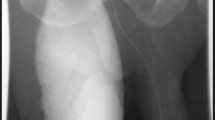Abstract
Introduction
Bladder injury (BI) represents a rare complication of inguinal hernia surgery. Protrusions of the urinary bladder through the deep inguinal ring (“bladder ears”) have been reported with an incidence of 9% in infants younger than 6 months of age and may be misinterpreted as the hernia sac. This literature review was designed to determine incidence and outcomes of bladder injuries during pediatric inguinal hernia repair.
Methods
A literature review of the literature (1967–2017) was performed using the keywords “bladder ears”, “inguinal hernia”, “iatrogenic bladder injury” and “bladder hernia”. Publications were reviewed for epidemiology, presentation and extent of injury, treatment and outcome.
Results
Thirteen articles reporting on 30 cases of BI during inguinal hernia repair from 1967 to 2017 were included (19 boys, 2 girls, 9 unknown). Median age at herniotomy was 10.5 months (1 month–6 years). Out of 30 children, 14 (47%) experienced mild complications. Sixteen patients (53%) had severe complications after initial surgery and needed revisional surgery. Complications were noticed up to 4 years after the initial surgery. In 9 (56%) of the 16 severe cases, major damage to the bladder wall and impairment of bladder capacity occurred. In seven patients (44%), secondary closure was successful. In ten patients (63%), the bladder was partially resected, and in one child (6%), the entire bladder was removed.
Conclusions
The degree of accidental BI during inguinal hernia repair was severe in in the majority of reported cases in the literature. Surgeons should be aware of the high prevalence of “bladder ears” in infants to prevent injury to the urinary tract.


Similar content being viewed by others
References
Miyano G, Yamataka A, Okada Y, Shimotakahara A, Kaneko K, Lane GJ, Yamashiro Y, Miyano T (2004) Sigmoidocolocystoplasty for augmentation of iatrogenic small capacity bladder caused by direct injury to the bladder during inguinal hernia repair: long-term follow-up. Pediatr Surg Int 20(1):61–64
Shaw A, Santulli TV (1967) Management of sliding hernias of the urinary bladder in infants. Surg Gynecol Obstetr 124(6):1314–1316
Allen RP, Condon VR (1961) Transitory extraperitoneal hernia of the bladder in infants (bladder ears). Radiology 77:979–983
Chang SJ, Chen JY, Hsu CK, Chuang FC, Yang SS (2016) The incidence of inguinal hernia and associated risk factors of incarceration in pediatric inguinal hernia: a nation-wide longitudinal population-based study. Hernia 20(4):559–563
Trobs RB, Yilmaz B, Roll C, Alrefai M (2017) Direct bladder hernia after indirect hernia repair in extremely low birth weight babies: two case reports and a review of the literature. J Med Case Rep 11(1):15
Redman JF, Ick KA (2001) Abdominoscrotal hydrocele mimicking a herniation of the bladder. South Med J 94(2):235–236
Colodny AH (1974) Bladder injury during herniorrhaphy. Manifested by ascites and azotemia. Urology 3(1):89–90
Flach A (1983) Fehler und Gefahren bei der chirurgischen Behandlung des Leistenbruches. Langenbecks Arch Chiv 361:343–346
Tiryaki T, Baskin D, Bulut M (1998) Operative complications of hernia repair in childhood. Pediatr Surg Int 13(2–3):160–161
Aloi IP, Lais A, Caione P (2010) Bladder injuries following inguinal canal surgery in infants. Pediatr Surg Int 26(12):1207–1210
Redman JF, Jacks DW, O'Donnell PD (1985) Cystectomy: a catastrophic complication of herniorrhaphy. J Urol 133(1):97–98
Koot VC, de Jong JR, van der Zee DC, Dik P (1998) Subtotal cystectomy as a complication of infant hernia repair. Eur J Surg 164(11):873–874
Chung HM, Yu TJ (1999) Bladder rupture after inguinal herniotomy. Pediatr Surg Int 15(8):584–585
Imamoglu M, Cay A, Sarihan H, Ahmetoglu A, Ozdemir O (2004) Paravesical abscess as an unusual late complication of inguinal hernia repair in children. J Urol 171(3):1268–1270
Zajaczkowski T (2007) Scrotal bladder hernia: report of two cases. Int Urol Nephrol 39(2):479–484
Wright N (2010) Baby's bladder removed by mistake. J Perioper Pract 20(6):194
Bakal U, Sarac M, Tartar T, Ersoz F, Kazez A (2015) Bladder perforations in children. Nigerian J Clin Pract 18(4):483–488
Funding
Not Applicable.
Author information
Authors and Affiliations
Corresponding author
Ethics declarations
Conflict of interest
The author(s) declare that they have no conflict of interest.
Additional information
Publisher's Note
Springer Nature remains neutral with regard to jurisdictional claims in published maps and institutional affiliations.
Rights and permissions
About this article
Cite this article
Duess, J.W., Schaller, MC., Lacher, M. et al. Accidental bladder injury during elective inguinal hernia repair: a preventable complication with high morbidity. Pediatr Surg Int 36, 235–239 (2020). https://doi.org/10.1007/s00383-019-04554-6
Accepted:
Published:
Issue Date:
DOI: https://doi.org/10.1007/s00383-019-04554-6




